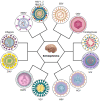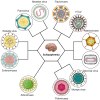Unravelling the Viral Hypothesis of Schizophrenia: A Comprehensive Review of Mechanisms and Evidence
- PMID: 40806558
- PMCID: PMC12347704
- DOI: 10.3390/ijms26157429
Unravelling the Viral Hypothesis of Schizophrenia: A Comprehensive Review of Mechanisms and Evidence
Abstract
Schizophrenia is a challenging multifactorial neuropsychiatric disease that involves interactions between genetic susceptibility and environmental insults. Increasing evidence implicates viral infections as significant environmental contributors, particularly during sensitive neurodevelopmental periods. This review synthesises current findings on the viral hypothesis of schizophrenia, encompassing a wide array of neurotropic viruses, including influenza viruses, herpesviruses (HSV-1 and 2, CMV, VZV, EBV, HHV-6 and 8), hepatitis B and C viruses, HIV, HERVs, HTLV, Zika virus, BoDV, coronaviruses (including SARS-CoV-2), and others. These pathogens can contribute to schizophrenia through mechanisms such as direct microinvasion, persistent central nervous system infection, immune-mediated neuroinflammation, molecular mimicry, and the disturbance of the blood-brain barrier. Prenatal exposure to viral infections can trigger maternal immune activation, resulting in cytokine-mediated alterations in the neurological development of the foetus that persist into adulthood. Genetic studies highlight the role of immune-related loci, including major histocompatibility complex polymorphisms, in modulating susceptibility to infection and neurodevelopmental outcomes. Clinical data also support the "mild encephalitis" hypothesis, suggesting that a subset of schizophrenia cases involve low-grade chronic neuroinflammation. Although antipsychotics have some immunomodulatory effects, adjunctive anti-inflammatory therapies show promise, particularly in treatment-resistant cases. Despite compelling associations, pathogen-specific links remain inconsistent, emphasising the need for longitudinal studies and integrative approaches such as viromics to unravel causal relationships. This review supports a "multi-hit" model in which viral infections interfere with hereditary and immunological susceptibilities, enhancing schizophrenia risk. Elucidating these virus-immune-brain interactions may facilitate the discovery of biomarkers, targeted prevention, and novel therapeutic strategies for schizophrenia.
Keywords: herpesviruses; immunogenetics; maternal immune activation; neuroinflammation; schizophrenia; viral infections; viromics.
Conflict of interest statement
The authors declare no conflicts of interest.
Figures


 ): inhibition.
): inhibition.




Similar articles
-
Prescription of Controlled Substances: Benefits and Risks.2025 Jul 6. In: StatPearls [Internet]. Treasure Island (FL): StatPearls Publishing; 2025 Jan–. 2025 Jul 6. In: StatPearls [Internet]. Treasure Island (FL): StatPearls Publishing; 2025 Jan–. PMID: 30726003 Free Books & Documents.
-
Ophthalmia Neonatorum.2025 Jul 7. In: StatPearls [Internet]. Treasure Island (FL): StatPearls Publishing; 2025 Jan–. 2025 Jul 7. In: StatPearls [Internet]. Treasure Island (FL): StatPearls Publishing; 2025 Jan–. PMID: 31855399 Free Books & Documents.
-
Short-Term Memory Impairment.2024 Jun 8. In: StatPearls [Internet]. Treasure Island (FL): StatPearls Publishing; 2025 Jan–. 2024 Jun 8. In: StatPearls [Internet]. Treasure Island (FL): StatPearls Publishing; 2025 Jan–. PMID: 31424720 Free Books & Documents.
-
The Black Book of Psychotropic Dosing and Monitoring.Psychopharmacol Bull. 2024 Jul 8;54(3):8-59. Psychopharmacol Bull. 2024. PMID: 38993656 Free PMC article. Review.
-
Management of urinary stones by experts in stone disease (ESD 2025).Arch Ital Urol Androl. 2025 Jun 30;97(2):14085. doi: 10.4081/aiua.2025.14085. Epub 2025 Jun 30. Arch Ital Urol Androl. 2025. PMID: 40583613 Review.
References
Publication types
LinkOut - more resources
Full Text Sources
Miscellaneous

